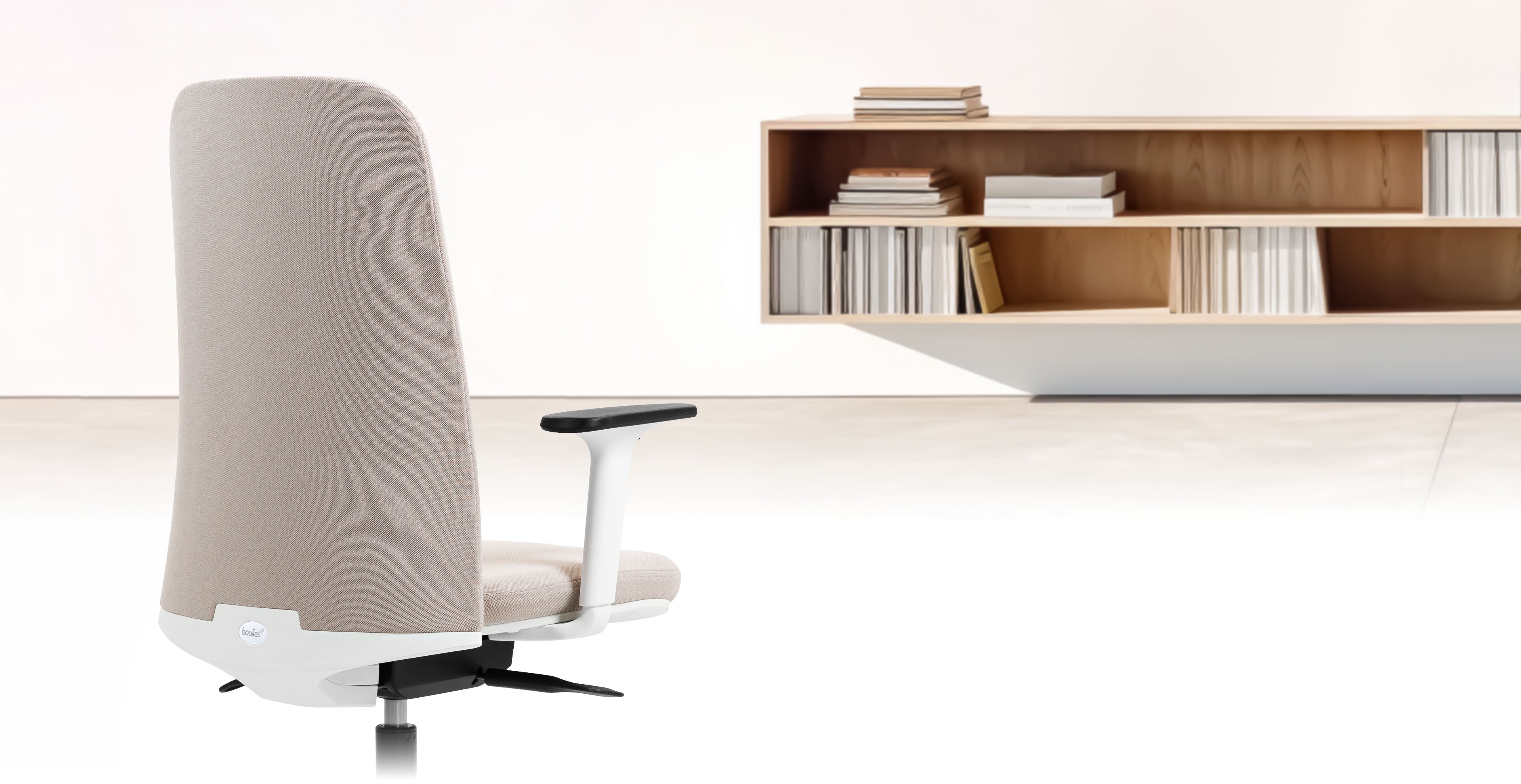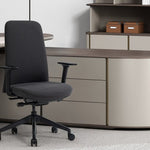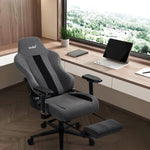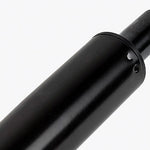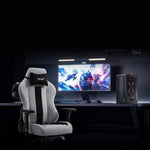Table of Contents
Struggling with office space planning? Learn key furniture dimensions to optimize comfort, efficiency, and workspace flow.
Cramming an office chair into a corner is asking for trouble. Get the right size, and your space will work. A desk should be 73 to 76 cm high - great for elbow nooks.
Make the desk at least 120 cm wide for the screen and space. Don't go any deeper than 60 cm or you'll be pushing things around looking for the keyboard.
A chair should have a seat height of 18 to 20 cm and a width of about 18 to 20 cm - no one likes to feel cramped. Drawers that are 18 inches deep don't block walkways. Filing cabinets should be about 28 to 28 inches high for folders.
A tape measure will stop regrets. Double-check measurements before you buy. No one wants a space that feels cramped. With the right furniture sizes, your office setup can really work.
Key Takeaways
- A desk that is 28 to 30 inches high, 40 to 60 inches wide and 24 to 30 inches deep gives you room to move around and reach for things.
- The chair needs to have a seat height of 45-55 cm, the backrest can be moved 5-10 cm, the armrest can be raised 17-23 cm, according to your sitting style.
- Leave a distance of 90-100 cm behind the chair, 120 cm between the table, the filing cabinet needs to have a distance of 75 cm when opened.
Office Furniture Dimensions - Get These Numbers Right

Space matters in an office. Good dimensions create flow. Bad ones create chaos.
Desk width needs breathing room. Go for 120-180 cm. Your files need 40-45 cm in cabinets - fits A4 paper perfect.
Height makes or breaks comfort. Keep desk surfaces at 73-76 cm from the floor. Let chairs move from 45-55 cm at the seat. Storage units can reach up to 200 cm - use that vertical space.
Depth is critical. Give desks 60-75 cm front to back. Screens need space. Typing needs room. File drawers want 45 cm deep - standard files fit just right.
Get these measurements wrong - get ready for headaches. Get them right - watch productivity soar. A tape measure is your best friend in office planning.
Desk Sizes That Work
Your desk tells your work story. Some spread wide. Some tuck away neat. Pick what fits your style.
Height matters - 73-76 cm keeps you working right. Your wrists stay happy. Your shoulders stay loose.
Depth needs 60-75 cm. That's front to back. Width starts at 120 cm. Need more space? Go up to 180 cm.
Pick Your Style:
- Straight desks - Simple at 120-150 cm wide. No drama. Just work
- L-shape desks - Corner heroes at 150 cm each way. Double the space
- Executive desks - Boss style at 180 cm wide 90 cm deep
- Sit-stand desks - Move from 65 cm to 130 cm. Your body thanks you
- Bench desks - Team players at 140-160 cm per spot
Get the size wrong - regret it daily. Get it right - work flows easy. Grab that measuring tape. Do it now.
Office Chairs - Size Matters
A well-fitted chair feels right. Your body knows. Your muscles relax. Work feels easier.
Height makes the difference. Look for 40-55 cm at the seat. Most people love 45-48 cm. Your feet stay flat. Your knees bend right.
Back support needs space. Give it 45-56 cm up from the seat. Want full support? Go 75 cm high. Your shoulders thank you.
Get the seat depth right - 38-48 cm does it. Thighs need support. Knees need freedom. Armrests work best at 17-23 cm above where you sit.
Bodies don't sit still. Good chairs move with you. They flex. They adjust. They support every shift.
Bad chair dimensions hurt productivity. The right ones make work flow. Your body knows the difference. Listen to it.
Storage Solutions: Filing Cabinets & Credenzas
Storage solutions is a good technique that has more importance than the normal techniques that are used for many different works. Currently, storage can do most of the work for example empty storage looks very wasteful and overstuffed storage creates chaos, with the help of different sizes you can do various tasks like organizing papers and files in manageable way.
Filing Cabinets
2-drawer unit is quite helpful that can fit under desk at 71 cm height. As of now 4-drawer units can reach 132 cm height and store many A4 folders, with the help of 45-60 cm depth you can keep papers straight and drawers working smooth.
Storage Cabinets & Credenzas
In office space, increase storage possibilities. Today, such units need 75 cm height and 180 cm width, and initially they need 45 cm depth for proper working. These measurements convey many things such as, built-in storage that takes no floor space and also natural elements like freestanding units which symbolize good flexibility.
Different sizes are used and with the help of proper measurements they make very organized storage that is of great use for office. Also people are benefited from this as they take proper size and use proper planning to avoid overflow problems.

Space Planning & Furniture Layout
Empty space in office design increases work efficiency. Today, such spaces need proper planning, and initially they need good furniture arrangement and now proper clearance too.
Desk Placement
Wall placement saves 60 cm space that is highly beneficial for focused work. These setups need many things such as, floating arrangement with 90 cm clearance and also corner spots which need 75 cm from walls.
Single vs. Bench Setups
Single desks need 180 cm x 180 cm space that includes proper clearance. Today you find bench systems like shared spaces and as such can come in handy for fitting more people with 120 cm per person.
Movement Space
Different clearances are used and with the help of 75-90 cm between desks they make very comfortable work environment. Also chair space needs 105 cm behind and walking paths need 120 cm width for proper movement.
Customization & Industry Standards
Furniture measurements is a complex system that has more variations than the normal measurements that are used for many different works. As of now furniture sizes can do most of the work for example when you visit showrooms you find both metric and imperial measurements, with the help of varied systems you can understand various sizes.
Standard Industry Sizes
Today, such measurements need proper checking as desk sold as 120×60 cm actually measures 119×59.5 cm, and initially they need A4 (210×297 mm) for filing systems and now some old units still use foolscap (203×330 mm).
Customization Options
Different heights are used and with the help of sit-stand desks they make very flexible work space that moves from 65 cm to 125 cm. Also, sizes are adjusted as good makers take 10 cm steps for width and 5 cm for depth. These measurements need many things such as cable ports of 6-8 cm and monitor arms need 10-12 cm space.
Practical Buying Considerations
Wrong measurements can make furniture stuck in doorways that is very dangerous. Today you find proper measuring like checking door openings of 76 cm and corridors of 90 cm and as such can come in handy. These spaces need proper planning as lifts have 200×150 cm limit and furniture needs 75-90 cm space around it.
Delivery & Assembly Logistics
Long parts in flat-pack rarely exceed 180 cm. Different times are used and with the help of proper planning they take 4–6 weeks for matching sets and need extra hands for heavy pieces over 25 kg.
Material Choices
Today such materials like solid oak weigh 30-40 kg per meter and steel legs hold 80-100 kg and 25 mm laminate tops handle daily use.
Office Design: A Measured Look at Modern Changes
Office furniture measurements is a good technique that has more importance than the normal techniques that are used for many different works.
As of now office design can do most of the work, for example a good design can make your workplace very organized, with the help of different strategies you can do various tasks like standing, sitting, and also complete your work efficiently during working hours.
Standing desk technology in modern offices increases efficiency and organization. Today, such desks need proper height adjustment from 65 cm to 125 cm, and initially they need electric motors that lift 120 kg and now 30 seconds position change too. These technologies make your work very manageable by giving you diverse possibilities.
Cable management adds many benefits to daily work. At present desk ports can take 6-8 cm space and wire channels need 10-15 cm depth, with the help of diverse methods like power units that take 25 cm square space you can do various works safely.
Different desk styles is used and with the help of proper measurements they make very organized work environment:
- Minimalist designs need 2-3 cm edges
- Wooden options take 4-5 cm thickness
- Metal frames use 5×5 cm profiles
These measurements make office design very efficient by giving you varied possibilities which help to complete your task. Today you find proper furniture like adaptable pieces and as such can come in handy in the current work culture. This design according to experts is extremely crucial to workplace efficiency and this proves just how important proper measurements are.

Frequently Asked Questions
How do I choose between a sit-stand desk and a fixed-height desk?
A sit-stand desk changes everything about how people work. Most fixed desks sit at 76 cm - fine if you've got a good chair, but limiting. Sit-stand models move from 65 to 125 cm, letting you stretch and shift. They cost more, sure, but that's like comparing a bicycle to a car.
Each desk type needs different space - sit-stand models want room to move, while fixed desks stay put. Watch out for cheap motors though, good ones lift 80 kg smooth as butter.
What's the ideal depth for a productive workspace?
Desk depth makes or breaks comfort. Most people reach about 50 cm comfortably - that's where keyboards and papers want to live. Screens need backing up another 20-25 cm, which is why 75 cm depth works best for most setups.
Laptop users might get by with 60 cm, but it feels tight. Remember the chair needs space too - about 90 cm to roll back without hitting walls. Those measurements keep arms happy and necks unstrained.
How much filing cabinet space do I really need?
Paper takes up less room than most think. A standard drawer holds roughly 1,250 sheets of A4, stacked neat. Two-drawer units (71 cm tall) suit most desk setups, while four-drawer ones (132 cm) work better against walls.
Width matters more than height sometimes - A4 folders need their full 45 cm side to side. Built-in cabinets save floor space but cost more to install. Start small, add more if needed.
What makes an ergonomic chair worth the investment?
Good chairs move with bodies. The best ones adjust everywhere - height from 45-55 cm, seat pan sliding 38-48 cm, arms moving up and back, lumbar support shifting to fit spines.
Cheap chairs feel fine for an hour; proper ones keep you comfortable all day. They last longer too, usually 8-10 years of daily use. The difference shows in shoulders and backs, especially after long days at screens.
How do I plan cable management for modern office furniture?
Cables make or break a clean desk setup. Each metre of desk needs at least one port (8 cm wide), more for power users. Under-desk trays catch the extras, running 15 cm deep along the back.
Power modules want spacing every 120 cm or so - that keeps extension leads off floors. Some clever desks build it all in, hiding ports under lift-up panels. Even wireless offices need backup plans for cables.
Conclusion
A walk through any office shows the truth about space. Too much stuff, too little planning - that's what turns workspaces into obstacle courses.
The numbers don't lie. A desk needs its 120-180 cm width, a chair wants 45-55 cm of height adjustment, and storage cabinets claim their 45-60 cm depth. Get these right, and work flows smooth as silk.
But it's not just about centimetres and squares. Watch how people move through their day:
- Elbows need room to spread papers
- Screens want proper distance
- Storage keeps clutter at bay
- Chair wheels roll free on proper mats
Smart planning starts with a tape measure and ends with comfort. Measure the space, check the doorways, think about power points. That's what makes an office work, whether it's tucked in a spare room or spread across an open plan.
Keep it simple, keep it measured, keep it practical. That's the secret to any good workspace.
